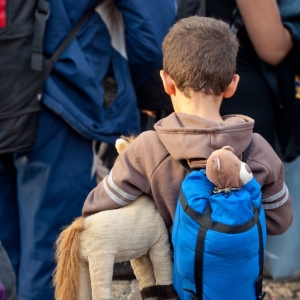Indicators in this domain assess the extent to which migrants have the same status as citizens in terms of access to basic social services such as health, education, and social security. It also describes the rights of migrants to family reunification, to work, and to residency and citizenship. The ratification of the main international conventions is also included within this domain.
Indicators in this category look at the extent to which migrants have access to certain social services such as health, education and social security. They also examine measures to ensure integration and access to work.
Indicators in this domain assess countries’ institutional, legal, and regulatory frameworks related to migration policies. Domain 2 also reviews the existence of national migration strategies that are in-line with development, as well as institutional transparency and coherence in relation to migration management. This domain also investigates the extent to which governments collect and use migration data.
Indicators in this category assess the institutional frameworks of cities for migration. This area also examines the existence of migration strategies consistent with development objectives, as well as institutional transparency and coherence in migration management.
This domain focuses on countries’ efforts to cooperate on migration-related issues with other states and with relevant non-governmental actors, including civil society organizations and the private sector. Cooperation can lead to improvements in governance by aligning and raising standards, increasing dialogue and providing structures to overcome challenges.
Indicators in this category focus on cities’ efforts to cooperate on migration issues with the national government as well as other cities and relevant non-governmental actors, including civil society organizations and the private sector.
This domain includes indicators on countries’ policies for managing the socioeconomic well-being of migrants, through aspects such as the recognition of migrants’ educational and professional qualifications, provisions regulating student migration and the existence of bilateral labour agreements between countries. Indicators equally focus on policies and strategies related to diaspora engagement and migrant remittances.
Indicators in this category assess cities’ initiatives in terms of international student mobility, access to the labour market and decent working conditions for migrant workers. Aspects related to diaspora engagement and migrant remittances are also included in this domain.
This domain studies the type and level of preparedness of countries when they are faced with mobility dimensions of crises, linked to either disasters, the environment and/or conflict. The questions are used to identify the processes in place for nationals and non-nationals both during and after disasters, including whether humanitarian assistance is equally available to migrants as it is to citizens.
Indicators in this category examine the type and level of readiness of cities to deal with aspects of mobility crises. The questions focus on the processes in place for citizens and non-citizens both during and after disasters, especially if humanitarian assistance is available for migrants and citizens.
This domain analyses countries’ approach to migration management in terms of border control and enforcement policies, admission criteria for migrants, preparedness and resilience in the case of significant and unexpected migration flows, as well as the fight against trafficking in human beings and smuggling of migrants. It also assesses efforts and incentives to help integrate returning citizens.
Indicators in this category look at the cities’ approaches to migrant safety as well as return and reintegration policies and the fight against trafficking in persons.
This country Profile describes examples of well-developed areas of the Democratic Republic of Timor-Leste’s (hereafter referred to as Timor-Leste) migration governance structures and areas with potential for further development, as evaluated through the six domains of the Migration Governance Indicators (MGI). These address migrants’ rights, a “whole-of-government” approach, partnerships, socioeconomic well-being of migrants, the mobility dimensions of crises, and safe and orderly migration.
Click the icons on the wheel to explore the key findings.
The Migration Governance Indicators (MGI) initiative is a policy-benchmarking programme led by the International Organization for Migration (IOM) and implemented with research and analysis from the Economist Intelligence Unit. Funding is provided by IOM Member States.
Migration governance: examples of well-developed areas
- Timorese citizens living abroad can vote in national, parliamentary and presidential elections, provided they are officially registered as voters.
- Access to vocational training is granted to all, with no discrimination based on nationality.
- The Immigration and Asylum Law provides for family reunification for family members of citizens, resident permit holders and refugees.
- Foreign workers contributing to the General Social Security Scheme have access to the same rights and benefits as nationals under that scheme.
Areas with potential for further development:
- The Secretary of State for Vocational Training and Employment periodically issues a list of occupations (mainly low skilled) that foreigners are not permitted to enter.
- There is no policy or strategy against hate crimes, violence, xenophobia and discrimination against migrants.
Migration governance: examples of well-developed areas
- The Law on Migration and Asylum outlines clearly the rights and obligations of immigrants; the process and conditions for obtaining different categories of visas, special stay authorization and residency.
- The Immigration Service collaborates with decentralized levels of government such as municipal authorities, mainly through the expansion of activities in the regions.
Areas with potential for further development:
- Timor-Leste does not have a dedicated government entity or agency responsible for enacting diaspora policies.
- Few sources of migration data exist in Timor-Leste, and they are scattered among various institutions.
Migration governance: examples of well-developed areas
- Timor-Leste is a member of several regional consultative processes on migration, including the Inter-governmental Asia-Pacific Consultations on Refugees, Displaced Persons and Migrants.
- In 2018, the country joined Australia’s Pacific Labour Scheme that enhances employment opportunities particularly in the horticulture and tourism sectors.
Areas with potential for further development:
- The Government only occasionally engages with the private sector on issues of migration, mostly on a consultative basis.
- Timor-Leste does not formally engage diaspora communities in agenda setting and policy development regarding migration issues.
Migration governance: examples of well-developed areas
- International students in Timor-Leste can obtain a work visa and be employed by local companies.
Areas with potential for further development:
- No specific legislation or policy has been developed to ensure the ethical recruitment of migrant workers.
- There is no strategy to enhance the benefits and facilitate the sending of remittances to and from Timor-Leste.
Migration governance: examples of well-developed areas
- Timor-Leste has developed contingency plans to address the effects of displacement.
- The National Directorate for Consular Issues and the National Directorate for Timorese Communities (Ministry of Foreign Affairs and Cooperation) assist Timorese nationals living abroad in times of crises, including in cases of repatriation and evacuation.
- The Law on Migration and Asylum includes provisions for granting temporary residency to foreigners in “exceptional cases”, including instances of humanitarian issues.
Areas with potential for further development:
- The country does not have a strategy for addressing migratory movements caused by environmental degradation and the adverse effects of climate change.
- There is no formal communication system during crises in Timor-Leste.
Migration governance: examples of well-developed areas
- Timor-Leste participates in consultative processes on countering smuggling and trafficking in persons, including the Bali Process.
- Border control staff often receive language courses as well as training on the detection of false documents and human trafficking.
Areas with potential for further development:
- Visa overstays are monitored by Immigration Service officials through their monitoring activities until the border management system becomes operational.
- The country does not have an overall strategy focusing on migrant reintegration.
2019 December




